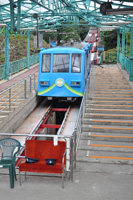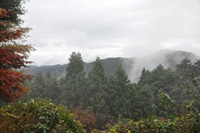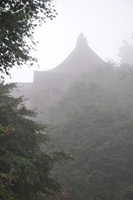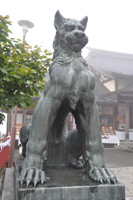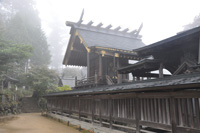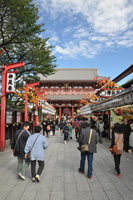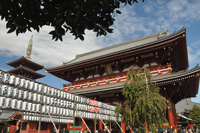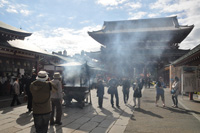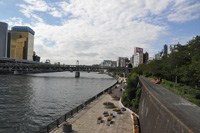 Mount Mitake is in the Chichibu Tama Kai National Park near Tokyo. It stands 929 m (3,048 ft) tall. On the mountain is a Shinto shrine. It is one of the many highlights of the Chichibu Tama Kai National Park, which covers more than 1,250 km2 (483 sq mi) of forested mountains, hills, gorges and some rural towns in the prefectures of Yamanashi, Saitama, Nagano and Tokyo. The trip from Tokyo's Shinjuku Station to Mitake Station on the Ōme Line takes about 95 minutes. A cable car leads to the village at its top. Many hikers access the mountain via Kori Station (two stops past Mitake Station from Ome). There is a hiking trail that takes approximately two and half hours to reach the summit, which passes Otsukayama (920 metres). Even with the weather being a bit sketchy there were a number of hikers the day I visited.
Mount Mitake is in the Chichibu Tama Kai National Park near Tokyo. It stands 929 m (3,048 ft) tall. On the mountain is a Shinto shrine. It is one of the many highlights of the Chichibu Tama Kai National Park, which covers more than 1,250 km2 (483 sq mi) of forested mountains, hills, gorges and some rural towns in the prefectures of Yamanashi, Saitama, Nagano and Tokyo. The trip from Tokyo's Shinjuku Station to Mitake Station on the Ōme Line takes about 95 minutes. A cable car leads to the village at its top. Many hikers access the mountain via Kori Station (two stops past Mitake Station from Ome). There is a hiking trail that takes approximately two and half hours to reach the summit, which passes Otsukayama (920 metres). Even with the weather being a bit sketchy there were a number of hikers the day I visited.
 Mount Mitake has been worshipped as a sacred mountain of Kanto and shukubo lodges have spread around the Musashi Mitake shrine. Among them, Komadori-Sanso is popular as a shukubo that offers takigyo (ascetic training of being hit by a waterfall) even to general people in Tokyo. To participate in this training, you leave the lodge at 5:30 in the morning and walk on a mountain path for half an hour to reach the waterfall. On the way, you see the Tengu-no-Koshikake cedar (a cedar tree that serves as a Tengu's chair), which is 350 years old and 60 meters high. It is a refreshing place with abundant nature everywhere. The lodge usually commands a good view of the valley into Tokyo.
Mount Mitake has been worshipped as a sacred mountain of Kanto and shukubo lodges have spread around the Musashi Mitake shrine. Among them, Komadori-Sanso is popular as a shukubo that offers takigyo (ascetic training of being hit by a waterfall) even to general people in Tokyo. To participate in this training, you leave the lodge at 5:30 in the morning and walk on a mountain path for half an hour to reach the waterfall. On the way, you see the Tengu-no-Koshikake cedar (a cedar tree that serves as a Tengu's chair), which is 350 years old and 60 meters high. It is a refreshing place with abundant nature everywhere. The lodge usually commands a good view of the valley into Tokyo.
 And I left after about an hour. The weather went from cool and mostly cloudy, to a cloud parking itself on the mountain and feeling it was about to snow. So, back to Tokyo, And it did snow in the north of Japan last night and on the mountains in the middle of the country where it was so warm last week. I definitely brought the right clothes, even if they weren't needed most of the trip. Also, I was disappointed to see my lodging. It was nothing like the pictures; instead it looked like the owners were horders. So much for living in the moment as it presents itself.
And I left after about an hour. The weather went from cool and mostly cloudy, to a cloud parking itself on the mountain and feeling it was about to snow. So, back to Tokyo, And it did snow in the north of Japan last night and on the mountains in the middle of the country where it was so warm last week. I definitely brought the right clothes, even if they weren't needed most of the trip. Also, I was disappointed to see my lodging. It was nothing like the pictures; instead it looked like the owners were horders. So much for living in the moment as it presents itself.
Asakusa (pronounced a-socks-a) is a district in Taitō, Tokyo, most famous for the Sensō-ji, a Buddhist temple dedicated to the bodhisattva Kannon. There are severa l more temples in Asakusa, as well as various festivals. Asakusa is on the north-east fringe of central Tokyo, at the eastern end of the Ginza subway line, approximately one mile east of the major Ueno railway/subway interchange. It is central to the area colloquially referred to as Shitamachi, which literally means "low city," referring to the low elevation of this old part of Tokyo, on the banks of the Sumida River. As the name suggests, the area has a more traditionally Japanese atmosphere than some other neighborhoods in Tokyo do.
l more temples in Asakusa, as well as various festivals. Asakusa is on the north-east fringe of central Tokyo, at the eastern end of the Ginza subway line, approximately one mile east of the major Ueno railway/subway interchange. It is central to the area colloquially referred to as Shitamachi, which literally means "low city," referring to the low elevation of this old part of Tokyo, on the banks of the Sumida River. As the name suggests, the area has a more traditionally Japanese atmosphere than some other neighborhoods in Tokyo do.
Be sure to go back and see the first pictures I took of this neighborhood in the gallery for my first night in Tokyo. It is a very quiet place at night, and conversely packed during the day. This is a nice neighborhood to walk in any time of day, and, for Tokyo, remarkably cheap.
